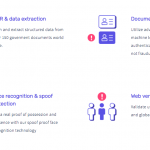Turning Data Into Dollars: 4 Steps for Valuing Insights (Ahead of Regulators)
For many marketers today, the key challenge in collecting customer information is figuring out how to best use it. In the near future, that challenge may change to putting a dollar sign on the data.
Consumer data and similar intangible assets could be worth more than $ 8 trillion, according to a recent Wall Street Journal story, citing Leonard Nakamura, an economist at the Federal Reserve Bank of Philadelphia. “That’s roughly equivalent to the gross domestic product of Germany, France and Italy combined.”
When those insights start making money, regulators pay attention. The Kroger Co., for example, is estimated to sell $ 100 million worth of data to suppliers such as Procter & Gamble Co. and Nestlé, according to the report. Sure enough, in September, members of the Financial Accounting Standards Board were advised to research intangible assets again; the third time since 2002.
It is no longer up for debate that customer data is becoming a more valued and tangible asset, as is evidenced in FASB’s repeated review into how to record these elements in financial records. Regulatory agencies are already pointedly asking companies to share their accounting methods regarding reward points and similar currencies. The Securities and Exchange Commission, for example, in the spring asked CVS/pharmacy to explain how it accounts for its outstanding loyalty currency, as it was not detailed in its quarterly report.
(CVS responded that while its ExtraCare expenses are charged to its cost of revenue, it does not believe the liability of its program offerings are material due to their short-term duration.)
When it comes to general data, however, those quantifications get murky. Consider that the value of today’s assets may change markedly in six months as consumer behaviors change, for instance. Further, the cost of time spent collecting and analyzing data would offset that value.
Despite these variables, there are some general guidelines marketers can follow to better prepare for regulatory guidelines when they come, and to understand the value of their data:
• Consider a CDO: Roughly 100 large organizations employ a chief data officer, according to research firm Gartner. Companies that manage large amounts of data will likely be better off in a year if they appoint someone now to manage information use. They also should ensure the position is well integrated with the executive team so everyone knows his or her role.
• Be perseverant: As earlier stated, data is fluid. Today’s best customer may be gone tomorrow, or replaced by another with completely different purchase preferences and behaviors. If a company is serious about tracking the value of its data assets, it needs to do so diligently and flexibly. This requires a regular auditing schedule and accountability. Companies that involve all logical teams in the process will likely fare better in this exercise.
• Reach out: Accounting strength comes in numbers. Merchants that lack the resources to invest in a suite of in-house data analysts have the opportunity to benefit from third-party consultants. Fortunately, several organizations specialize in loyalty marketing and data analysis, including ours.
• Keep future value in mind: Concentrate on efforts to capture only the data the organization needs, recognizing in the process that the data not only is a valuable asset now, but in the future the acquisition, management and maintenance of that data asset may have beneficial accounting implications.
The customer experiences that data insights make possible can be, to quote MasterCard, priceless, but the value it brings to companies is not. Accounting standards are likely just a matter of time, and smart organizations will be ready.
Business Articles | Business 2 Community
(126)













